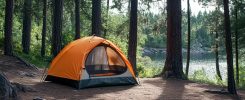Camping in cold weather presents unique challenges, but with the right gear, it can be an unforgettable adventure. Whether you’re setting up camp in the snow, exploring high-altitude trails, or braving frigid temperatures in remote areas, having reliable equipment is crucial. Proper insulation, durable clothing, and specialized camping accessories can make all the difference in staying warm, safe, and comfortable. In this guide, we’ll explore the best cold-weather camping gear, recommended by experts, to help you prepare for extreme outdoor conditions.
The Foundation of Cold-Weather Camping: Layering and Insulation
The key to staying warm while camping in cold weather is layering. Experts recommend using the three-layer system to regulate body temperature and moisture:
- Base Layer (Moisture-Wicking Layer)
- Choose merino wool or synthetic thermal underwear to wick away sweat.
- Avoid cotton, as it retains moisture and can lead to rapid heat loss.
- Mid Layer (Insulating Layer)
- A down or synthetic-insulated jacket provides essential warmth.
- Fleece pullovers are a great lightweight option for added insulation.
- Outer Layer (Weatherproof Layer)
- A waterproof and windproof shell protects against snow, rain, and strong winds.
- Look for Gore-Tex or eVent materials to ensure breathability while staying dry.
A well-planned layering system keeps you warm without overheating, allowing you to adjust as temperatures fluctuate.
Cold-Weather Sleeping System: Staying Warm at Night
One of the biggest challenges in winter camping is maintaining warmth while sleeping. To prevent heat loss during the night, invest in a high-quality sleeping bag, sleeping pad, and insulated liner.
Sleeping Bag: Choose the Right Temperature Rating
- Select a four-season sleeping bag rated for temperatures 10°F (-12°C) or lower.
- Down-filled bags offer superior warmth-to-weight ratio but require careful moisture management.
- Synthetic bags retain insulation even when damp and are a great budget-friendly option.
Sleeping Pad: Insulation from the Ground
- A sleeping pad with a high R-value (4.5 or above) is essential to prevent cold from seeping through the ground.
- Closed-cell foam pads provide additional insulation beneath an inflatable pad for extra warmth.
Liners and Accessories for Extra Heat
- A thermal sleeping bag liner can add 10–15°F (5–8°C) of warmth.
- Heated sleeping pads and hot water bottles placed in your bag help keep feet warm on frigid nights.
Essential Cold-Weather Camping Clothing
Beyond layering, having the right outerwear and accessories will keep you protected from freezing temperatures.
Jackets and Pants
- Down parkas with high fill power (750+) provide warmth with minimal bulk.
- Waterproof snow pants or insulated softshell pants prevent windchill and moisture penetration.
Gloves and Headgear
- Insulated, waterproof gloves or mittens are necessary to protect hands from frostbite.
- A fleece-lined beanie or balaclava prevents heat loss from the head, which accounts for up to 10% of body heat loss.
Footwear: Insulated Winter Boots
- Waterproof, insulated boots with at least 400g of insulation are ideal for cold-weather trekking.
- Wool socks and thermal foot warmers keep feet dry and warm.
Cold-Weather Camping Cooking and Hydration
Proper nutrition and hydration are crucial in cold climates. Since the body burns more calories to maintain warmth, having a high-energy food supply and a reliable cooking system is vital.
Stoves for Winter Camping
- Liquid-fuel stoves (white gas or multi-fuel) perform better in freezing temperatures compared to propane canisters, which lose pressure in the cold.
- Windshields and insulated covers for stoves improve efficiency in snowy conditions.
High-Calorie Foods for Cold Weather
- Dehydrated meals with high fat and protein content provide sustained energy.
- Nut butters, trail mix, and oatmeal are excellent for quick fuel.
Preventing Water from Freezing
- Insulated water bottles or vacuum flasks keep liquids from freezing overnight.
- Store bottles upside down—water freezes from the top down, so the opening remains clear.
Winter Camping Shelter: Choosing the Right Tent
A standard tent won’t cut it in extreme cold. For winter conditions, you’ll need a four-season tent built to withstand heavy snow and strong winds.
What to Look for in a Winter Tent
- Double-wall construction for superior insulation.
- Sturdy aluminum poles designed for high winds.
- Snow flaps and reinforced guy lines for anchoring in deep snow.
If camping in extreme alpine conditions, consider a mountaineering tent with extra durability.
Expert Winter Camping Tips
- Keep Batteries Warm: Cold temperatures drain battery life quickly. Store headlamp and GPS batteries in an inner pocket close to your body.
- Ventilate Your Tent: Prevent condensation by leaving a small vent open, even in freezing weather.
- Stay Dry: Sweat leads to heat loss, so adjust layers frequently to avoid overheating.
- Use Hand Warmers Smartly: Place chemical warmers in gloves, boots, or inside your sleeping bag for added warmth.
Conclusion
Cold-weather camping can be an exhilarating experience when you have the right gear and preparation. Investing in quality insulated clothing, a reliable sleeping system, and a proper winter tent can make all the difference in staying warm and safe. By following expert recommendations and choosing gear designed for extreme conditions, you’ll be ready to embrace winter camping adventures with confidence.
